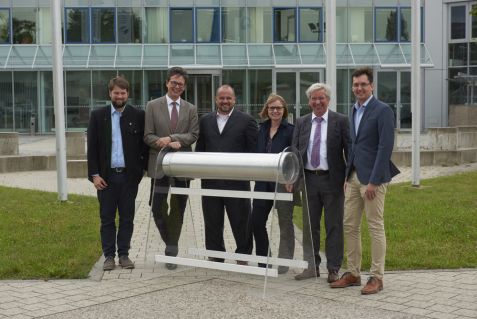MLZ is a cooperation between:
 > Technische Universität München
> Technische Universität München > Helmholtz-Zentrum Hereon
> Helmholtz-Zentrum Hereon
 > Forschungszentrum Jülich
> Forschungszentrum Jülich
MLZ is a member of:
 > LENS
> LENS > ERF-AISBL
> ERF-AISBL
MLZ on social media:

MLZ (eng)
Lichtenbergstr.1
85748 Garching
30.07.2019
Working together on the path to conversion

From left: Dr. Christian Reiter (TUM), Prof. Peter Müller-Buschbaum (TUM), Christopher Landers (DoE), Dr. Ulrike Kirste (StMWK), Prof. Winfried Petry (TUM), Bruno Baumeister (TUM) in front of a model of a fuel element of FRM II. © W. Schürmann / TUM
Technische Universität München as operator of the neutron source Heinz Maier-Leibnitz (FRM II) actively participates in international fuel research with the aim to develop new nuclear fuels with lower enrichment and increased uranium density for high performance research reactors such as the FRM II. The working group “High density fuels” works on the three main pillars fuel development, fuel manufacturing and theoretical core modelling.
For the conversion of FRM II towards a lower enriched fuel, three possible fuel candidates were identified: (high-density) uranium silicide (U3Si2), disperse uranium-molybdenum (U-Mo) as well as monolithic U-Mo. Because of the lowest possible enrichment – due to the highest achievable uranium density – TUM focuses its research on monolithic U-Mo. Only this fuel allows to pursue the perspective goal – a compatible core design using low enriched uranium (LEU). The research on the other two fuel candidates is mainly performed by the partners within the HERACLES consortium. To support a core design based on monolithic U-Mo, TUM is leading the development and establishment of a European manufacturing process for such fuels.
For all these topics, the working group “High density fuels” cooperates with European partners from industry and science within the HERACLES consortium. Furthermore, close cooperation exists with the US Department of Energy as well as with the associated National Laboratories, e.g. Argonne National Laboratory (ANL) and Idaho National Laboratory (INL).
On Friday 12th July, TUM has hosted the US Department of Energy (DoE) and the Bavarian State Ministry for Science and the Arts (StMWK) at the FRM II site to discuss the joint international efforts to minimize the use of highly-enriched uranium (HEU) in the civil fuel cycle and to further strengthen this cooperation. Prof. Winfried Petry, Dr. Christian Reiter and Bruno Baumeister presented the progress and most recent results in fuel development, fuel manufacturing and theoretical core modelling to Christopher Landers, Director for the US National Nuclear Security Administration’s Office of Conversion and to Dr. Ulrike Kirste from StMWK. In particular, the attendees have discussed the remaining challenges on the way to the conversion of FRM II to a compatible, lower enriched fuel element with only marginal losses in scientific performance.
After the meeting, Christopher Landers stated: “The international community is working together to ensure all research reactors, both old and new, will operate using low-enriched uranium (LEU), in contrast to the historically-used highly enriched uranium (HEU). The meeting today with experts from the FRM II reactor and the Bavarian State Ministry for Science and Art was an important step forward in our joint cooperation on the conversion of the FRM II to use LEU fuel. All parties agreed to develop a technical program between FRM II and U.S. national laboratories, as well as to establish a government-to-government oversight group to help achieve a successful conversion of the FRM II reactor. The United States looks forward to working closely with Germany and the FRM II reactor, as well as with our other partners around the world, to eliminate the civil use of HEU.”
As next steps, the attendees agreed to establish a technical program in the fields of fuel development, fuel manufacturing and theoretical core modelling between TUM and Argonne National Laboratory (ANL) as well as further bilateral meetings in the near future.
Further information
MLZ is a cooperation between:
 > Technische Universität München
> Technische Universität München > Helmholtz-Zentrum Hereon
> Helmholtz-Zentrum Hereon
 > Forschungszentrum Jülich
> Forschungszentrum Jülich
MLZ is a member of:
 > LENS
> LENS > ERF-AISBL
> ERF-AISBL
MLZ on social media:


